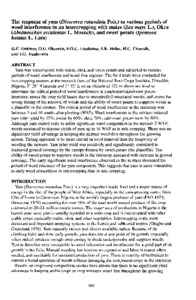| dc.contributor.author | Orkwor, G. |
| dc.contributor.author | Okereke, O. |
| dc.contributor.author | Ezedinma, C. |
| dc.contributor.author | Hahn, S. |
| dc.contributor.author | Ezumah, H. |
| dc.contributor.author | Akobundu, I. |
| dc.date.accessioned | 2019-12-04T11:26:22Z |
| dc.date.available | 2019-12-04T11:26:22Z |
| dc.date.issued | 1994 |
| dc.identifier.citation | Orkwor, G., Okereke, O., Ezedinma, C., Hahn, S., Ezumah, H. & Akobundu, I. (1994). Response of yam (Dioscorea rotundata Poir.) to various periods of weed interference in an intercropping with maize (Zea mays L.), okra (Abelmoschus esculentus L. Moench), and sweet potato (Ipomoea batatas L. Lam). Acta Horticulturae, 380, 349-354. |
| dc.identifier.issn | 0567-7572 |
| dc.identifier.uri | https://hdl.handle.net/20.500.12478/4563 |
| dc.description.abstract | Yam was intercropped with maize, okra, and sweet potato and subjected to various periods of weed interference and weed-free regimes. The field trials were conducted for two cropping seasons at the research farm of the National Root Crops Institute, Umudike, Nigeria, 5° 29' N latitude and 7° 32' E on an altitude of 122 m above sea level to determine the critical period of weed interference in yam/maize/okra/sweet potato intercrop; assess the crop yield losses due to uncontrolled associated weeds; and assess the wrong timing of the removal of weeds and the ability of sweet potato to suppress weeds as a planofile in the mixture. The critical period of weed interference in the intercrop was between 3 and 16 weeks after planting (WAP). Weed interference in the mixture reduced yam tuber yield by 35%; maize by 60%; okra, 79%, and sweet potato roots by 80%. Although yam started early to suffer significant weed competition in the mixture 3 WAP; weeds continued to depress yields of yam up to 16 WAP as in sole cropping. There was no significant yield advantage in keeping the mixture weed-free throughout the growing season. Timing appeared to be more crucial in weed removal than the frequency of weeding the mixture. Yam tuber yield was positively and significantly correlated to increased ground coverage by the canopy formed by sweet potato (the planofile). The ability of sweet potato to suppress weeds in the intercrop increased with increase in ground coverage. The early significant weed interference observed in the mixture shortened the period of weed tolerance of the yam component. This suggests that yam is more vulnerable to early weed competition in intercropping than in sole cropping. |
| dc.description.sponsorship | United Nations Development Programme |
| dc.language.iso | en |
| dc.subject | Yams |
| dc.subject | Weed Control |
| dc.subject | Intercropping |
| dc.subject | Humid Tropics |
| dc.title | Response of yam (Dioscorea rotundata Poir.) to various periods of weed interference in an intercropping with maize (Zea mays L.), okra (Abelmoschus esculentus L. Moench), and sweet potato (Ipomoea batatas L. Lam) |
| dc.type | Journal Article |
| dc.description.version | Peer Review |
| cg.contributor.affiliation | University of Nigeria |
| cg.contributor.affiliation | International Institute of Tropical Agriculture |
| cg.contributor.affiliation | University of Ibadan |
| cg.contributor.affiliation | Michael Okpara University of Agriculture |
| cg.coverage.region | Africa |
| cg.coverage.region | West Africa |
| cg.coverage.country | Nigeria |
| cg.authorship.types | CGIAR and developing country institute |
| cg.iitasubject | Food Security |
| cg.iitasubject | Yam |
| cg.iitasubject | Crop Systems |
| cg.iitasubject | Weeds |
| cg.iitasubject | Climate Change |
| cg.accessibilitystatus | Limited Access |
| local.dspaceid | 100813 |
| cg.identifier.doi | https://doi.org/10.17660/ActaHortic.1994.380.54 |

